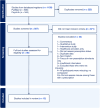Misuse and diversion of stimulant medications prescribed for the treatment of ADHD: a systematic review
- PMID: 40698051
- PMCID: PMC12280905
- DOI: 10.3389/fpsyt.2025.1612785
Misuse and diversion of stimulant medications prescribed for the treatment of ADHD: a systematic review
Abstract
Aim: Stimulant medications are an evidence-based treatment for ADHD. However, stimulant medications are associated with a risk of misuse and diversion. Given the paucity of research, this systematic review evaluates the prevalence of misuse and diversion of stimulant medication by those who are prescribed the medication for a diagnosis of ADHD, and explores risk factors for misuse and diversion.
Methods: This systematic review was registered with PROSPERO (CRD42023469041). A systematic search of original articles from PubMed and PsycInfo on the topic of interest over a period of 10 years (2012-2023) was conducted. Risk of bias was assessed through JBI Critical Appraisal Checklist for Prevalence Studies. A meta-analysis was conducted using JBI SUMARI software.
Results: Twelve cross sectional surveys met the inclusion criteria, with study populations ranging from 88 respondents to 10,000 respondents. Meta-analysis found an average prevalence of past year prescription stimulant medication misuse of 22.6%, past year diversion of 18.2%, and lifetime diversion of 17.9%. Risk factors for misuse included being prescribed an amphetamine-based stimulant, reporting comorbid depressive and anxiety symptoms, and believing that misuse was not associated with risks. Risk factors for diversion included exposure to peers who were misusing stimulant medication, and having surplus medication available.
Conclusion: With more than one in five people reporting misuse of their prescribed stimulant medication, and one in six diverting their prescribed stimulant medication, comprehensive risk assessment and risk mitigation strategies are needed. Further research in a variety of geographic and demographic settings is needed to develop effective risk assessment tools and targeted interventions.
Keywords: ADHD; diversion; psychotropic medications; stimulant misuse; systematic review.
Copyright © 2025 Forrest, Chen and Jagadheesan.
Conflict of interest statement
The authors declare that the research was conducted in the absence of any commercial or financial relationships that could be construed as a potential conflict of interest.
Figures
References
-
- APA. American Psychiatric Association . Desk Reference to the Diagnostic Criteria from DSM-5. Arlington, VA: American Psychiatric Association; (2013).
-
- AIHW . Australian institute of health and welfare. In: Australia’s children Canberra: Australian Institute of Health and Welfare (2022). Available at: https://www.aihw.gov.au/reports/children-youth/Australias-children (Accessed January 1, 2025).
-
- ADHD Guideline Development Group . Australian evidence-based clinical practice guideline for Attention Deficit Hyperactivity Disorder. Melbourne: Australian ADHD Professionals Association; (2022).
Publication types
LinkOut - more resources
Full Text Sources
Miscellaneous






